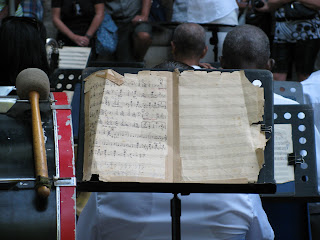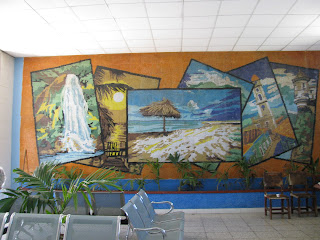Back to Havana – May 6 to 8, 2011
We were excited to be joined in Varadero by our friends on Ajaya whom we had not been able to say a proper goodbye to. Hugs over the radio waves are just not a good substitute for the real thing. We were also able to join them for another dose of Havana.
Back on the 8 AM bus with short stops at the new Varadero airport, Matanzas and the DIY pina colada bar. We travelled light with just our backpacks containing a couple of changes of clothing, some toiletries, cameras and a guide book. Oh yes, and as always, a supply of toilet paper.
Dagoberto’s rooms were already occupied but Marie Elena had two available with a shared bath. We dropped off our luggage and headed out on foot.
The Mexican Navy was in town with a tall ship open for tours. We chose to keep moving rather than spend time in a long queue (choice of words for our British travelling companions).
Although we had taken a horse and buggy ride on our first visit we did a repeat. As expected, we saw more than a few things that we had missed on the first go around.
A well restored façade.
A bit of Moorish influence.
As always, there was usually live music within earshot or signs that it was about to happen.
Well worn sheet music in use by a member of the full orchestra performing in one of the public squares.
On a corner not connected to any railway tracks that we noticed, several old engines were sitting in various stages of repair. The idle yard person told us that there was no work that he could do until some parts became available. We understood that this equipment is expected to be put back into service.
The population of Cuba is reported to be 1 percent Asian and Marie Elena’s casa is located on the edge of Havana’s Chinatown. Why not Chinese food for dinner?
The fare at the Tien Tan, while very edible, did not resemble any dishes that we would have recognized. I suspect that there were a few ingredient substitutions.
One of these paintings has migrated to our condo storage unit waiting for a wall to be hung on some day.
Markets in the city offer a few conveniences that the village markets do not have.
You can purchase coconut pre-shredded so you do not have to do it yourself at home.
Similarily, cabbage is thinly pre-sliced and sold in convenient meal sized packages.
The Bacardi family and their trademark rum played a major role in Cuban history in the 19th and early 20th centuries. The beautiful and outwardly well maintained Edificio Bacardi is an excellent example of Art Deco architecture that was completed in 1930. Lunch on the mezzanine level gave us a leisurely opportunity to enjoy the interior decoration.
A shot of the well restored art deco interior.
From the inside looking out.
In May 2011 the top floor lookout was officially closed but unofficially a couple of CUC’s got us access to a level near the top of the building where the view was breathtaking. It was easier to breath normally with our backs pressed up against the wall.
Edificio Bacardi
Yes, there are jineteros (hustlers) in Havana. But what options do they have when advertising does not exist? One such hustler struck up a conversation with us as we walked down the sidewalk and insisted that we stop for a drink at the bar on the corner. After all, the piano player, Amaranto Fernandez reportedly used to play with the Buena Vista Social Club although the official website does not mention his name in the list of muscians. Who knows?
The gang with Amaranto.
We continue to enjoy the traditional Cuban music from the CD we purchased.
The troupe of stilt walkers had a change of costume since our last visit.
The Hop-On, Hop-Off bus in Havana provided us with an inexpensive opportunity to see more of the city than what was in easy walking distance of the Capitolio Nacional. For five dollars we could ride all day. The round trip took over two hours without us even hopping off once. There was plenty to see from the top of the double decker bus.
Santaria practitioners. Santeria is an Afro-Cuban religion that is a blend of beliefs rooted in West African and Spanish Catholicism.
Another way to see Havana.
Socialism. Today, tomorrow and always.
For our return to Varadero we tried to arrange for the same classic American car that we hired on our last trip but it wasn’t available. It was either otherwise occupied, broken down or the trip not profitable enough to make it worthwhile for the driver.
A little confusion over the departure time of the bus from the terminal downtown resulted in a bit of a wait and time to enjoy the lovely mosaic and have a bit of late lunch.
Apparently my Spanish speaking abilities had improved as I was able to explain to the non-English speaking driver that we would like to get off the bus at the marina instead of going all the way in ti downtown Varadero.
Relevant Reading: The Rudder – The Magazine for Yachtsmen, December 1949
We found this old American sailing magazine in Havana. Plaza de Armas is a permanent booksellers market where racks of pre-revolutionary books and magazines are on offer.
Besides a few issues of The Rudder we saw many issues of National Geographic and other magazines from the ‘40’s and ‘50s.
Our 1949 find contains an article on “Cruising the South Coast of Florida” by Dr. R.L. Walford who, with his crew of one, took the long route from the continental US to Puerto Rico by rounding the western end of Cuba and sailing the southern coast in a deep draft, 40 foot cutter.
Without all of the modern navigation equipment that we use today they had to rely on lead lines to read the water depths (very importance due to the abundance of reefs that surround the island), coastal landmarks like odd shaped hills and sugar mill stacks to identify their position and a fire on shore to identify the coastline during a night passage. To measure their speed when they lost the spinner from their knot log line they threw a stick in the water at the bow and timed how long it took to reach the stern. Professional weather routers did not yet exist and they had to contend with whatever weather they encountered when it happened. It is amazing that they only went aground three times.
At Cochinos Bay (Bay of Pigs) they enlisted the services of a professional crocodile hunter to help them obtain a rare specimen for the National Zoo in Washington, DC. After carrying their live catch on board to Cienfuergos, foiling a near escape in the process, they determined that their passenger was not the species they were looking for and released it back into the sea. Today, Cochinos bay is a tourist attraction where many people go on day trips from their all-inclusive resorts.
Santiago de Cuba was their last port of call before heading for other distant shores. We have visited the harbours of Cienfuegos and Santiago by land. Perhaps another year we will visit them from the sea.
Our friends, Phil and Nikki, purchased a 1955 issue of The Rudder. In it we found an advertisement for sailing charters in the Bahamas.
The offer was being made by none other than Randolph Johnston, the Canadian ex-pat sculptor of Man-O-War Cay who later moved to Little Harbour to establish his foundry. See my Relevant Reading post from December 2009 – Leaving the Bahamas.



























No comments:
Post a Comment